Accounting Principles: Trial Balance, Adjustments, and Financials
VerifiedAdded on 2023/06/04
|13
|2239
|413
Report
AI Summary
This report provides a detailed analysis of business accounting concepts, starting with an unadjusted trial balance for Paul Services as of June 30, 2016. It includes adjustment journal entries based on given adjustments, leading to the preparation of an adjusted trial balance. The report then constructs an income statement, closes journal entries, and presents the balance sheet and statement of changes in equity. Furthermore, it discusses the necessity of financial statements, explaining the purpose and importance of trial balances, adjustment entries, adjusted trial balances, and closing entries in ensuring accurate financial reporting and adherence to accounting principles such as matching and accrual concepts.

Paraphrase This Document
Need a fresh take? Get an instant paraphrase of this document with our AI Paraphraser
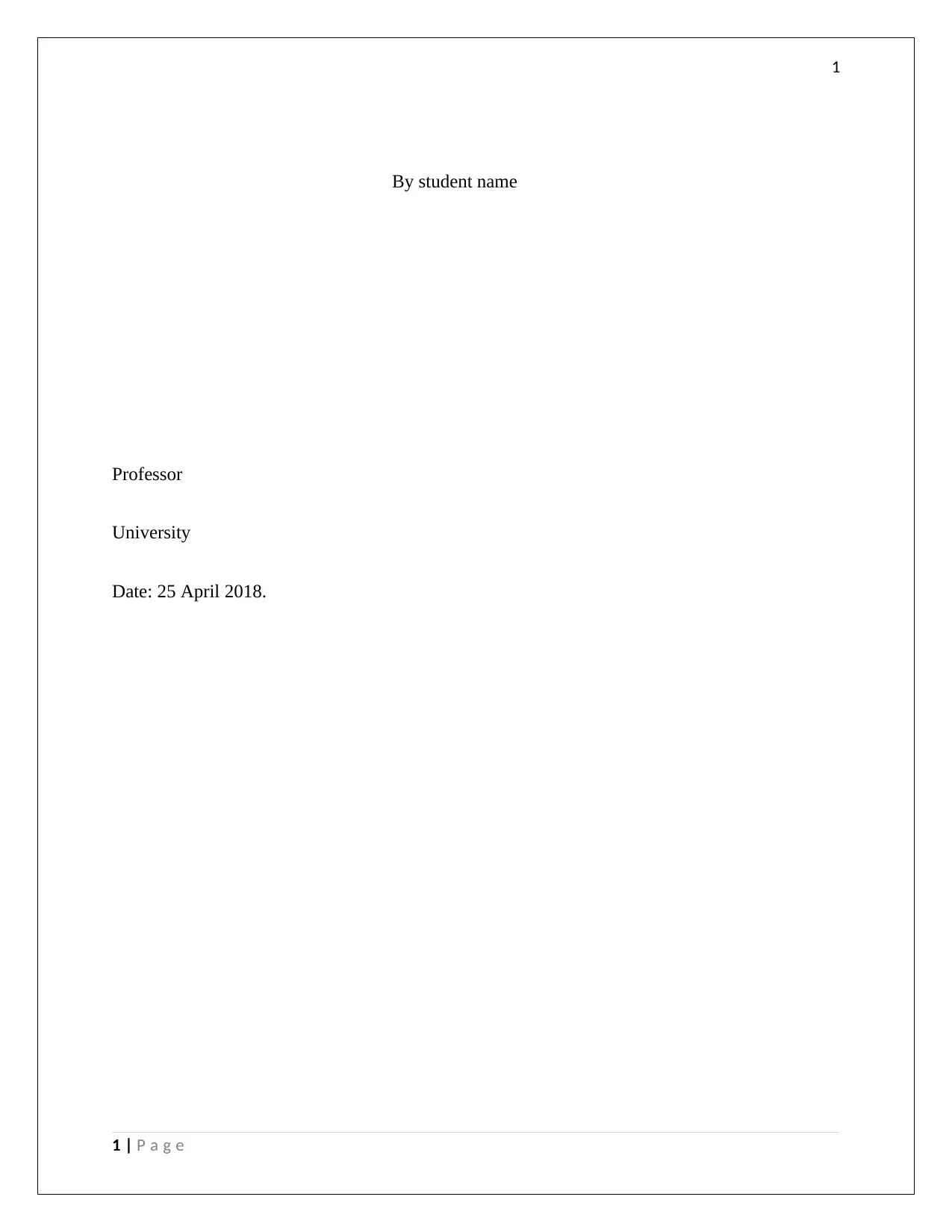
1
By student name
Professor
University
Date: 25 April 2018.
1 | P a g e
By student name
Professor
University
Date: 25 April 2018.
1 | P a g e
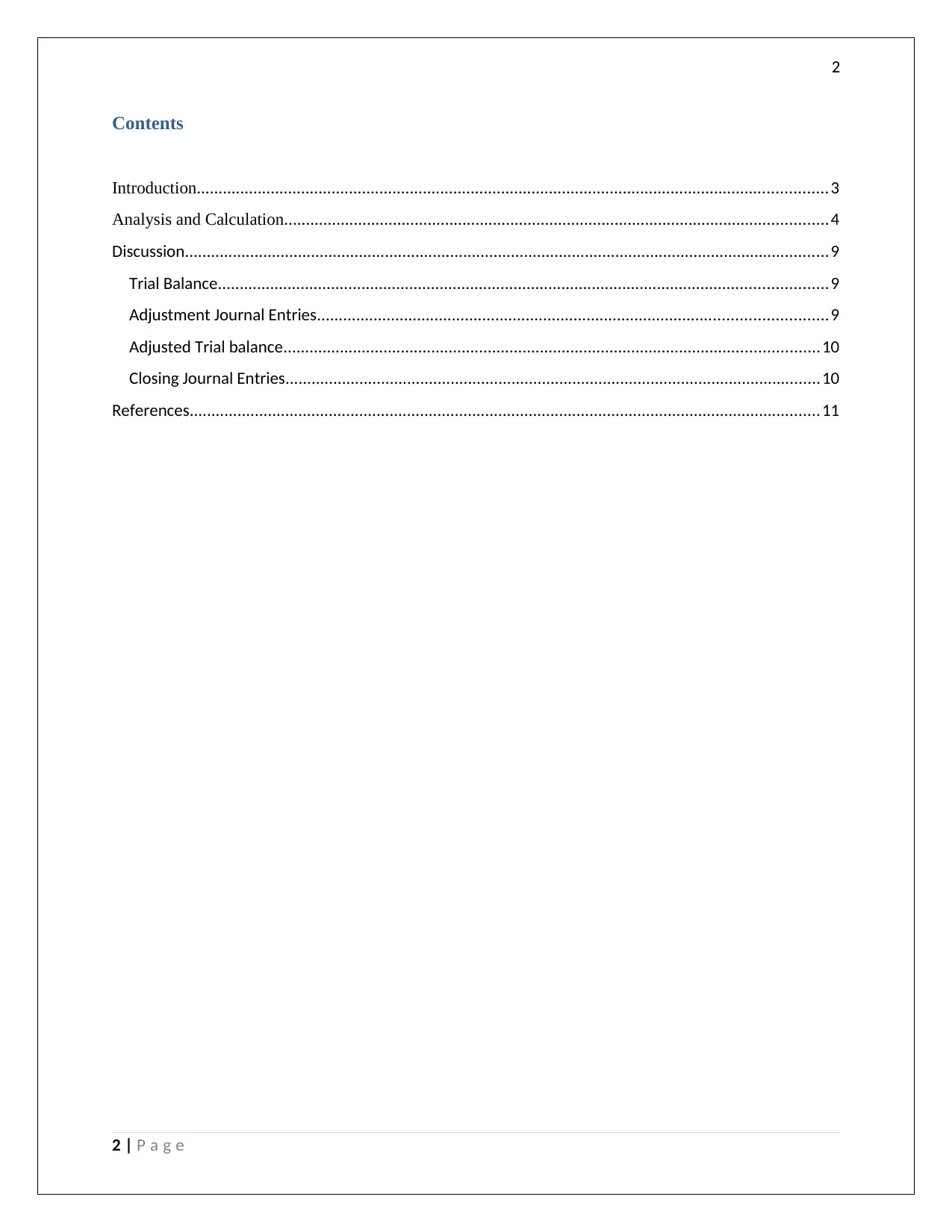
2
Contents
Introduction.................................................................................................................................................3
Analysis and Calculation.............................................................................................................................4
Discussion....................................................................................................................................................9
Trial Balance............................................................................................................................................9
Adjustment Journal Entries.....................................................................................................................9
Adjusted Trial balance...........................................................................................................................10
Closing Journal Entries...........................................................................................................................10
References.................................................................................................................................................11
2 | P a g e
Contents
Introduction.................................................................................................................................................3
Analysis and Calculation.............................................................................................................................4
Discussion....................................................................................................................................................9
Trial Balance............................................................................................................................................9
Adjustment Journal Entries.....................................................................................................................9
Adjusted Trial balance...........................................................................................................................10
Closing Journal Entries...........................................................................................................................10
References.................................................................................................................................................11
2 | P a g e
⊘ This is a preview!⊘
Do you want full access?
Subscribe today to unlock all pages.

Trusted by 1+ million students worldwide

3
Introduction
A report has been prepared on the business accounting concepts. The unadjusted Trial Balance
of the company has been given along with the sheet showing the various adjustments. The
journal entries have been passed based on the adjustment given and the adjusted trial balance
has been prepared (Dumay & Baard, 2017). Post this the income statement has been prepared
and the closing entries have been passed in the journal books. Finally the balance sheet and the
statement of changes in equity was also being plotted. Post the analysis section, the theoretical
question on the need of financial statements and why the same is being prepared has been
done.
3 | P a g e
Introduction
A report has been prepared on the business accounting concepts. The unadjusted Trial Balance
of the company has been given along with the sheet showing the various adjustments. The
journal entries have been passed based on the adjustment given and the adjusted trial balance
has been prepared (Dumay & Baard, 2017). Post this the income statement has been prepared
and the closing entries have been passed in the journal books. Finally the balance sheet and the
statement of changes in equity was also being plotted. Post the analysis section, the theoretical
question on the need of financial statements and why the same is being prepared has been
done.
3 | P a g e
Paraphrase This Document
Need a fresh take? Get an instant paraphrase of this document with our AI Paraphraser
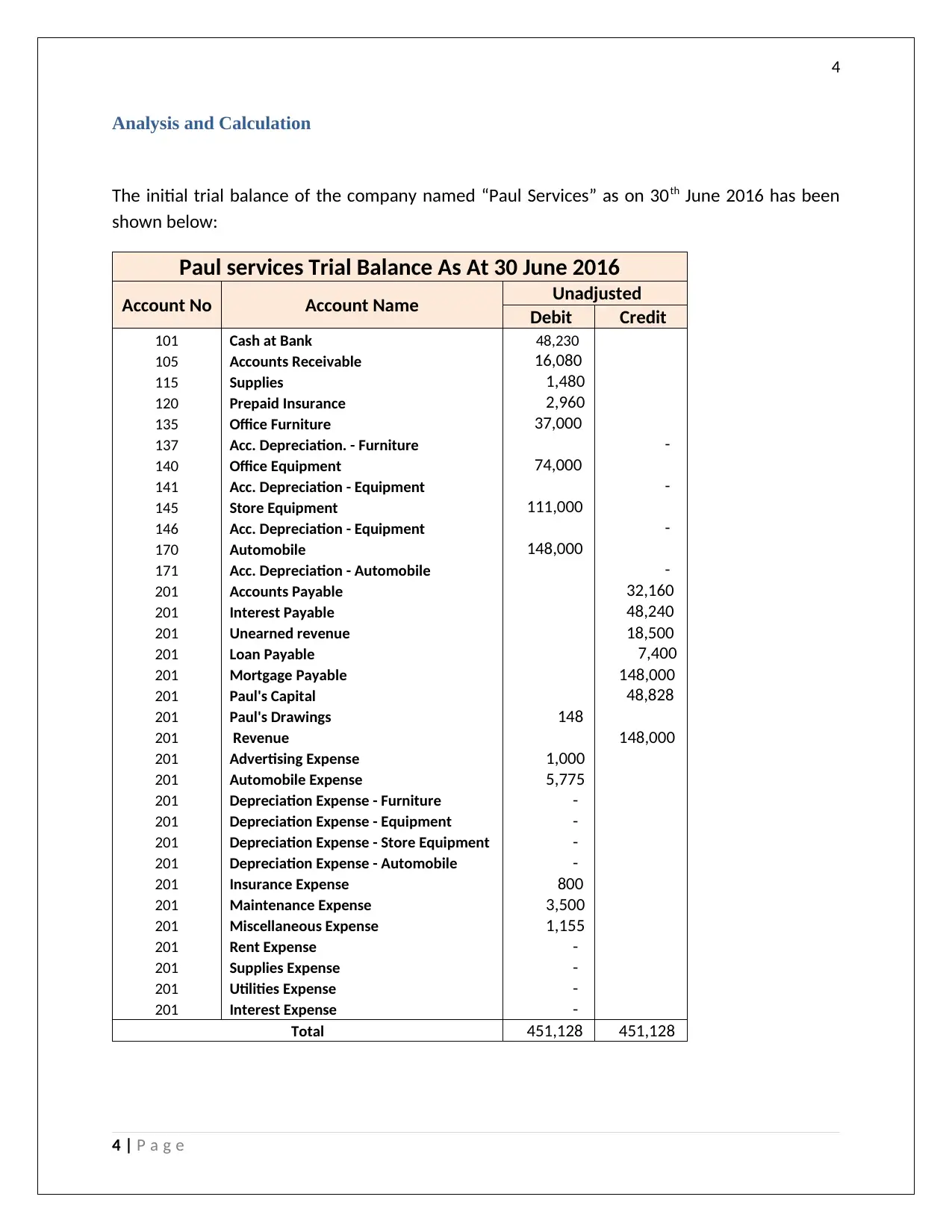
4
Analysis and Calculation
The initial trial balance of the company named “Paul Services” as on 30th June 2016 has been
shown below:
Paul services Trial Balance As At 30 June 2016
Account No Account Name Unadjusted
Debit Credit
101 Cash at Bank 48,230
105 Accounts Receivable 16,080
115 Supplies 1,480
120 Prepaid Insurance 2,960
135 Office Furniture 37,000
137 Acc. Depreciation. - Furniture -
140 Office Equipment 74,000
141 Acc. Depreciation - Equipment -
145 Store Equipment 111,000
146 Acc. Depreciation - Equipment -
170 Automobile 148,000
171 Acc. Depreciation - Automobile -
201 Accounts Payable 32,160
201 Interest Payable 48,240
201 Unearned revenue 18,500
201 Loan Payable 7,400
201 Mortgage Payable 148,000
201 Paul's Capital 48,828
201 Paul's Drawings 148
201 Revenue 148,000
201 Advertising Expense 1,000
201 Automobile Expense 5,775
201 Depreciation Expense - Furniture -
201 Depreciation Expense - Equipment -
201 Depreciation Expense - Store Equipment -
201 Depreciation Expense - Automobile -
201 Insurance Expense 800
201 Maintenance Expense 3,500
201 Miscellaneous Expense 1,155
201 Rent Expense -
201 Supplies Expense -
201 Utilities Expense -
201 Interest Expense -
Total 451,128 451,128
4 | P a g e
Analysis and Calculation
The initial trial balance of the company named “Paul Services” as on 30th June 2016 has been
shown below:
Paul services Trial Balance As At 30 June 2016
Account No Account Name Unadjusted
Debit Credit
101 Cash at Bank 48,230
105 Accounts Receivable 16,080
115 Supplies 1,480
120 Prepaid Insurance 2,960
135 Office Furniture 37,000
137 Acc. Depreciation. - Furniture -
140 Office Equipment 74,000
141 Acc. Depreciation - Equipment -
145 Store Equipment 111,000
146 Acc. Depreciation - Equipment -
170 Automobile 148,000
171 Acc. Depreciation - Automobile -
201 Accounts Payable 32,160
201 Interest Payable 48,240
201 Unearned revenue 18,500
201 Loan Payable 7,400
201 Mortgage Payable 148,000
201 Paul's Capital 48,828
201 Paul's Drawings 148
201 Revenue 148,000
201 Advertising Expense 1,000
201 Automobile Expense 5,775
201 Depreciation Expense - Furniture -
201 Depreciation Expense - Equipment -
201 Depreciation Expense - Store Equipment -
201 Depreciation Expense - Automobile -
201 Insurance Expense 800
201 Maintenance Expense 3,500
201 Miscellaneous Expense 1,155
201 Rent Expense -
201 Supplies Expense -
201 Utilities Expense -
201 Interest Expense -
Total 451,128 451,128
4 | P a g e
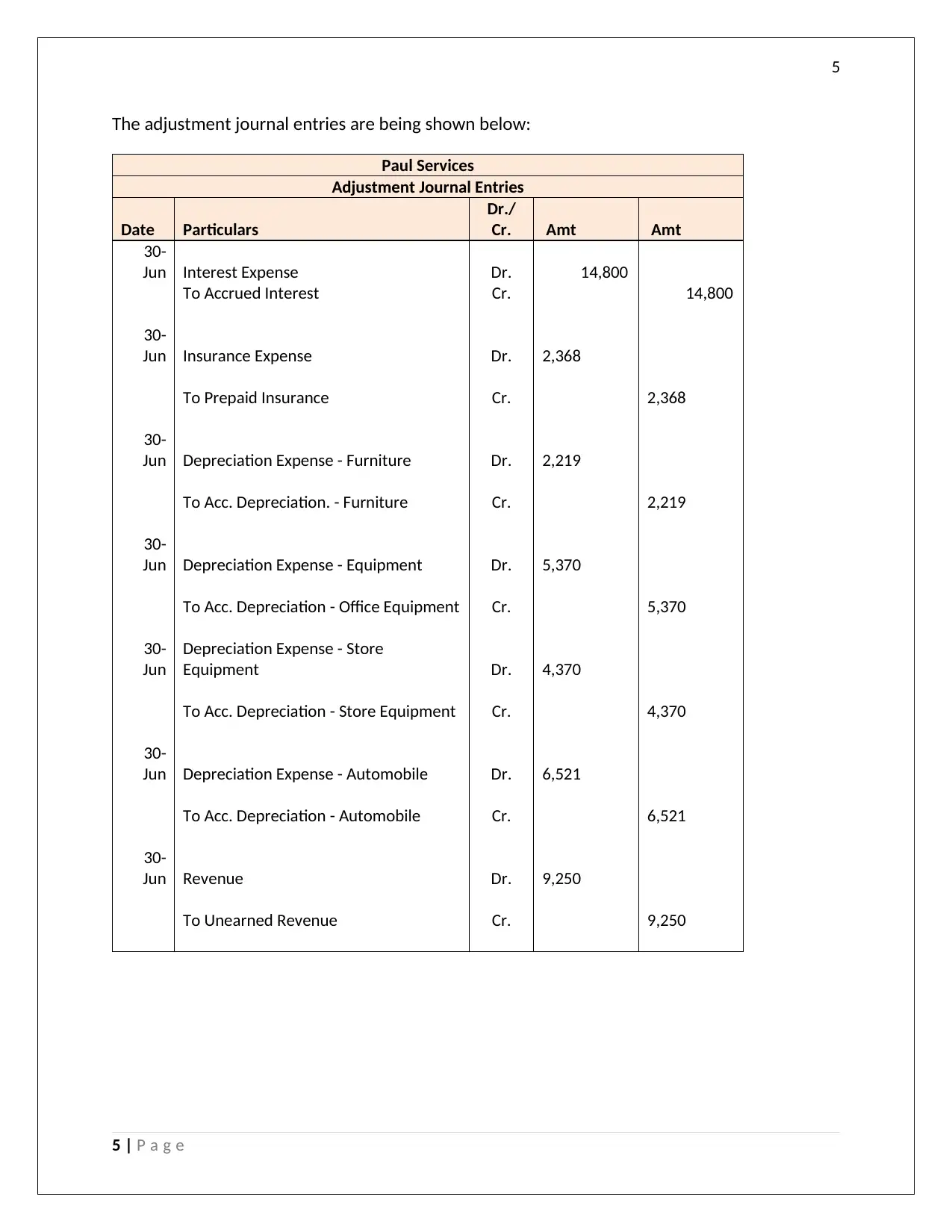
5
The adjustment journal entries are being shown below:
Paul Services
Adjustment Journal Entries
Date Particulars
Dr./
Cr. Amt Amt
30-
Jun Interest Expense Dr. 14,800
To Accrued Interest Cr. 14,800
30-
Jun Insurance Expense Dr. 2,368
To Prepaid Insurance Cr. 2,368
30-
Jun Depreciation Expense - Furniture Dr. 2,219
To Acc. Depreciation. - Furniture Cr. 2,219
30-
Jun Depreciation Expense - Equipment Dr. 5,370
To Acc. Depreciation - Office Equipment Cr. 5,370
30-
Jun
Depreciation Expense - Store
Equipment Dr. 4,370
To Acc. Depreciation - Store Equipment Cr. 4,370
30-
Jun Depreciation Expense - Automobile Dr. 6,521
To Acc. Depreciation - Automobile Cr. 6,521
30-
Jun Revenue Dr. 9,250
To Unearned Revenue Cr. 9,250
5 | P a g e
The adjustment journal entries are being shown below:
Paul Services
Adjustment Journal Entries
Date Particulars
Dr./
Cr. Amt Amt
30-
Jun Interest Expense Dr. 14,800
To Accrued Interest Cr. 14,800
30-
Jun Insurance Expense Dr. 2,368
To Prepaid Insurance Cr. 2,368
30-
Jun Depreciation Expense - Furniture Dr. 2,219
To Acc. Depreciation. - Furniture Cr. 2,219
30-
Jun Depreciation Expense - Equipment Dr. 5,370
To Acc. Depreciation - Office Equipment Cr. 5,370
30-
Jun
Depreciation Expense - Store
Equipment Dr. 4,370
To Acc. Depreciation - Store Equipment Cr. 4,370
30-
Jun Depreciation Expense - Automobile Dr. 6,521
To Acc. Depreciation - Automobile Cr. 6,521
30-
Jun Revenue Dr. 9,250
To Unearned Revenue Cr. 9,250
5 | P a g e
⊘ This is a preview!⊘
Do you want full access?
Subscribe today to unlock all pages.

Trusted by 1+ million students worldwide
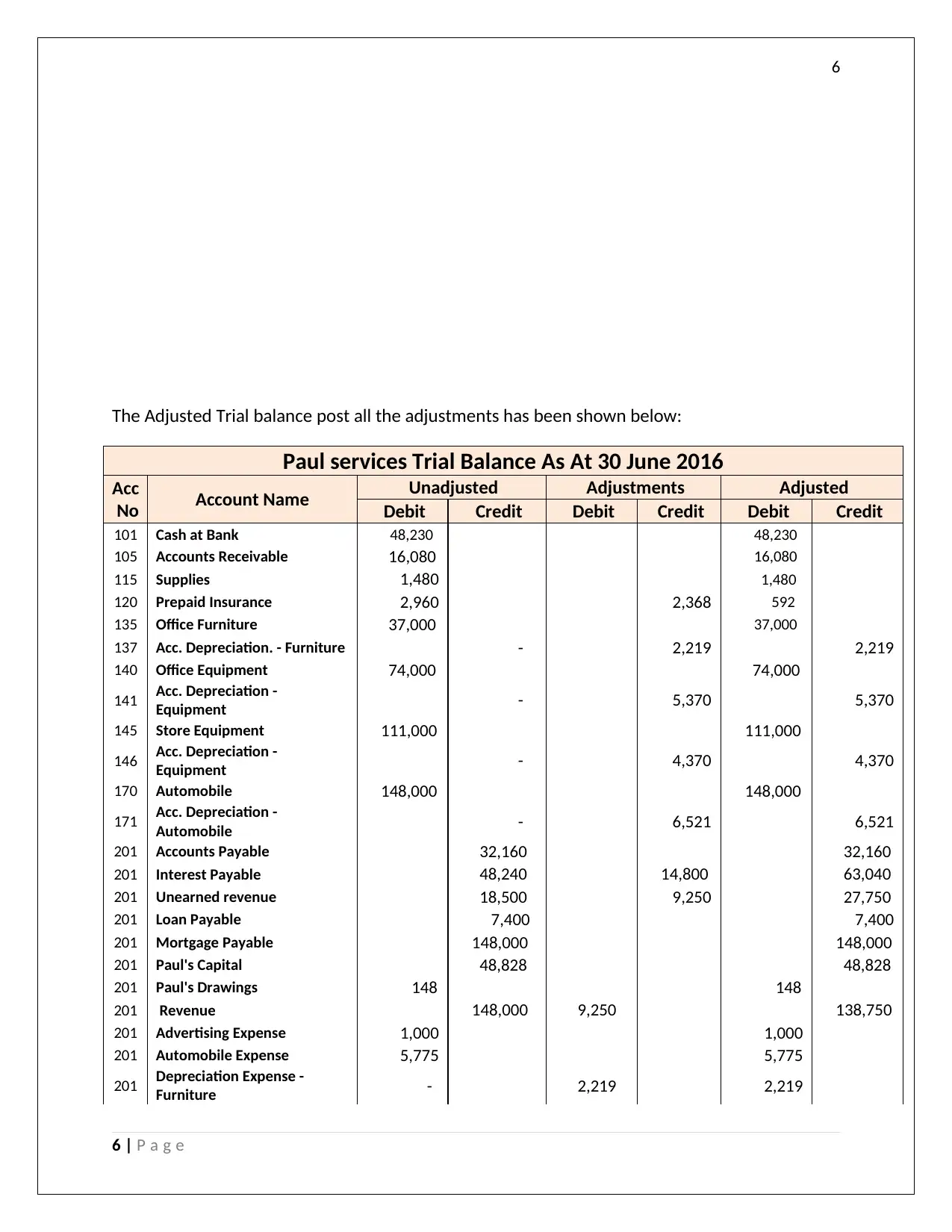
6
The Adjusted Trial balance post all the adjustments has been shown below:
Paul services Trial Balance As At 30 June 2016
Acc
No Account Name Unadjusted Adjustments Adjusted
Debit Credit Debit Credit Debit Credit
101 Cash at Bank 48,230 48,230
105 Accounts Receivable 16,080 16,080
115 Supplies 1,480 1,480
120 Prepaid Insurance 2,960 2,368 592
135 Office Furniture 37,000 37,000
137 Acc. Depreciation. - Furniture - 2,219 2,219
140 Office Equipment 74,000 74,000
141 Acc. Depreciation -
Equipment - 5,370 5,370
145 Store Equipment 111,000 111,000
146 Acc. Depreciation -
Equipment - 4,370 4,370
170 Automobile 148,000 148,000
171 Acc. Depreciation -
Automobile - 6,521 6,521
201 Accounts Payable 32,160 32,160
201 Interest Payable 48,240 14,800 63,040
201 Unearned revenue 18,500 9,250 27,750
201 Loan Payable 7,400 7,400
201 Mortgage Payable 148,000 148,000
201 Paul's Capital 48,828 48,828
201 Paul's Drawings 148 148
201 Revenue 148,000 9,250 138,750
201 Advertising Expense 1,000 1,000
201 Automobile Expense 5,775 5,775
201 Depreciation Expense -
Furniture - 2,219 2,219
6 | P a g e
The Adjusted Trial balance post all the adjustments has been shown below:
Paul services Trial Balance As At 30 June 2016
Acc
No Account Name Unadjusted Adjustments Adjusted
Debit Credit Debit Credit Debit Credit
101 Cash at Bank 48,230 48,230
105 Accounts Receivable 16,080 16,080
115 Supplies 1,480 1,480
120 Prepaid Insurance 2,960 2,368 592
135 Office Furniture 37,000 37,000
137 Acc. Depreciation. - Furniture - 2,219 2,219
140 Office Equipment 74,000 74,000
141 Acc. Depreciation -
Equipment - 5,370 5,370
145 Store Equipment 111,000 111,000
146 Acc. Depreciation -
Equipment - 4,370 4,370
170 Automobile 148,000 148,000
171 Acc. Depreciation -
Automobile - 6,521 6,521
201 Accounts Payable 32,160 32,160
201 Interest Payable 48,240 14,800 63,040
201 Unearned revenue 18,500 9,250 27,750
201 Loan Payable 7,400 7,400
201 Mortgage Payable 148,000 148,000
201 Paul's Capital 48,828 48,828
201 Paul's Drawings 148 148
201 Revenue 148,000 9,250 138,750
201 Advertising Expense 1,000 1,000
201 Automobile Expense 5,775 5,775
201 Depreciation Expense -
Furniture - 2,219 2,219
6 | P a g e
Paraphrase This Document
Need a fresh take? Get an instant paraphrase of this document with our AI Paraphraser

7
201 Depreciation Expense -
Equipment - 5,370 5,370
201 Depreciation Expense - Store
Equipment - 4,370 4,370
201 Depreciation Expense -
Automobile - 6,521 6,521
201 Insurance Expense 800 2,368 3,168
201 Maintenance Expense 3,500 3,500
201 Miscellaneous Expense 1,155 1,155
201 Rent Expense - -
201 Supplies Expense - -
201 Utilities Expense - -
201 Interest Expense - 14,800 14,800
Total 451,128 451,128 44,897 44,897 484,407 484,407
The income statement of the company for the year ended 30th June 2016 is shown below:
Paul Services
Income Statement
For the period ended 30th June 2016
Particulars Amt ($) Amt ($)
Revenue 138,750
Less: Expenses
Advertising Expense 1,000
Automobile Expense 5,775
Depreciation Expense - Furniture 2,219
Depreciation Expense - Equipment 5,370
Depreciation Expense - Store Equipment 4,370
Depreciation Expense - Automobile 6,521
Insurance Expense 3,168
Maintenance Expense 3,500
Miscellaneous Expense 1,155
Supplies Expense 1,110
Interest Expense 14,800 48,987
Net Profit 89,763
The closing journal entries for the company for the period ended 30th June 2016 is shown
below:
Paul Services
Closing Journal Entries
Date Particulars Dr./Cr. Amt Amt
30-Jun Revenue Account Dr. 138,750
To Profit and Loss Account Cr. 138,750
30-Jun Profit and Loss Account Dr. 48,987
To Advertising Expense Cr. 1,000
To Automobile Expense Cr. 5,775
7 | P a g e
201 Depreciation Expense -
Equipment - 5,370 5,370
201 Depreciation Expense - Store
Equipment - 4,370 4,370
201 Depreciation Expense -
Automobile - 6,521 6,521
201 Insurance Expense 800 2,368 3,168
201 Maintenance Expense 3,500 3,500
201 Miscellaneous Expense 1,155 1,155
201 Rent Expense - -
201 Supplies Expense - -
201 Utilities Expense - -
201 Interest Expense - 14,800 14,800
Total 451,128 451,128 44,897 44,897 484,407 484,407
The income statement of the company for the year ended 30th June 2016 is shown below:
Paul Services
Income Statement
For the period ended 30th June 2016
Particulars Amt ($) Amt ($)
Revenue 138,750
Less: Expenses
Advertising Expense 1,000
Automobile Expense 5,775
Depreciation Expense - Furniture 2,219
Depreciation Expense - Equipment 5,370
Depreciation Expense - Store Equipment 4,370
Depreciation Expense - Automobile 6,521
Insurance Expense 3,168
Maintenance Expense 3,500
Miscellaneous Expense 1,155
Supplies Expense 1,110
Interest Expense 14,800 48,987
Net Profit 89,763
The closing journal entries for the company for the period ended 30th June 2016 is shown
below:
Paul Services
Closing Journal Entries
Date Particulars Dr./Cr. Amt Amt
30-Jun Revenue Account Dr. 138,750
To Profit and Loss Account Cr. 138,750
30-Jun Profit and Loss Account Dr. 48,987
To Advertising Expense Cr. 1,000
To Automobile Expense Cr. 5,775
7 | P a g e
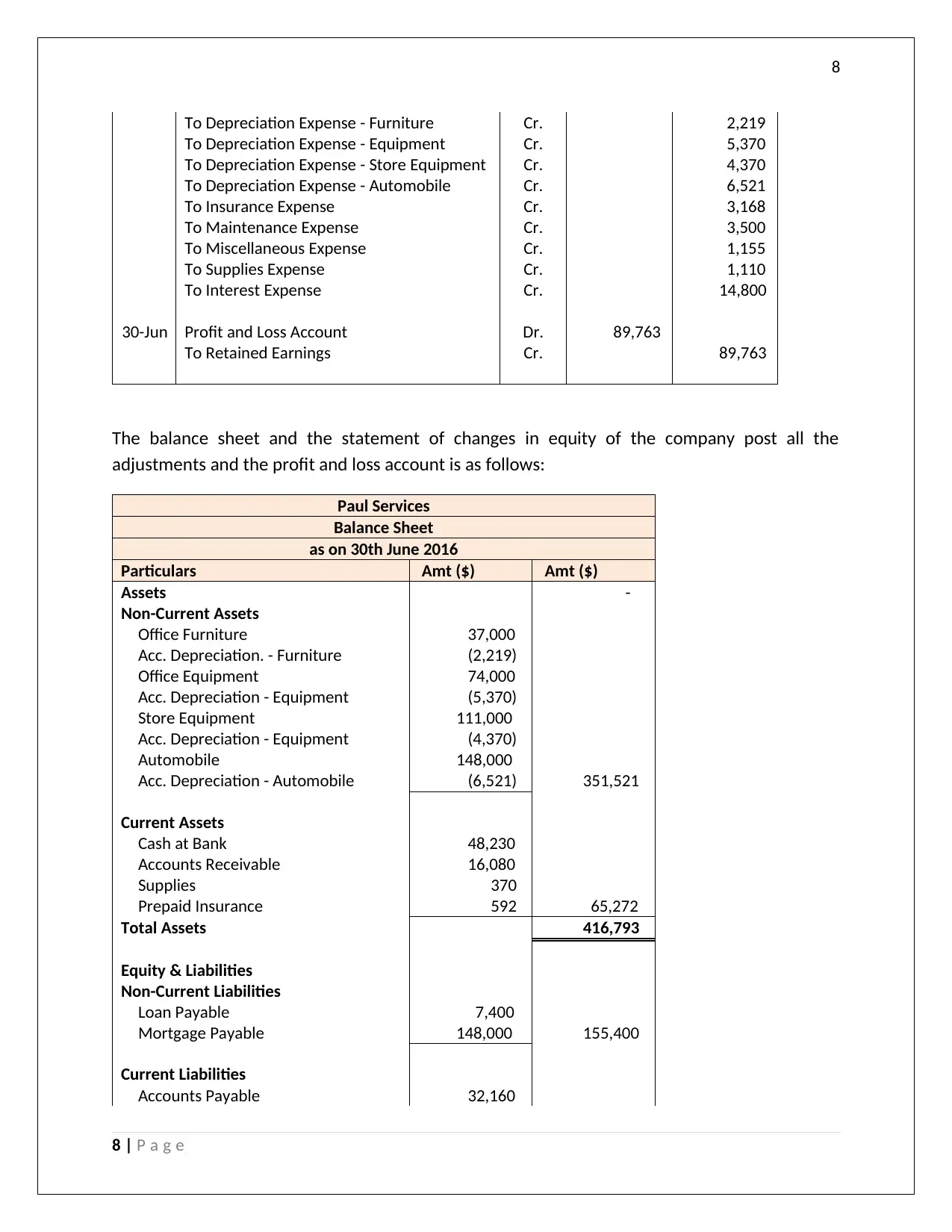
8
To Depreciation Expense - Furniture Cr. 2,219
To Depreciation Expense - Equipment Cr. 5,370
To Depreciation Expense - Store Equipment Cr. 4,370
To Depreciation Expense - Automobile Cr. 6,521
To Insurance Expense Cr. 3,168
To Maintenance Expense Cr. 3,500
To Miscellaneous Expense Cr. 1,155
To Supplies Expense Cr. 1,110
To Interest Expense Cr. 14,800
30-Jun Profit and Loss Account Dr. 89,763
To Retained Earnings Cr. 89,763
The balance sheet and the statement of changes in equity of the company post all the
adjustments and the profit and loss account is as follows:
Paul Services
Balance Sheet
as on 30th June 2016
Particulars Amt ($) Amt ($)
Assets -
Non-Current Assets
Office Furniture 37,000
Acc. Depreciation. - Furniture (2,219)
Office Equipment 74,000
Acc. Depreciation - Equipment (5,370)
Store Equipment 111,000
Acc. Depreciation - Equipment (4,370)
Automobile 148,000
Acc. Depreciation - Automobile (6,521) 351,521
Current Assets
Cash at Bank 48,230
Accounts Receivable 16,080
Supplies 370
Prepaid Insurance 592 65,272
Total Assets 416,793
Equity & Liabilities
Non-Current Liabilities
Loan Payable 7,400
Mortgage Payable 148,000 155,400
Current Liabilities
Accounts Payable 32,160
8 | P a g e
To Depreciation Expense - Furniture Cr. 2,219
To Depreciation Expense - Equipment Cr. 5,370
To Depreciation Expense - Store Equipment Cr. 4,370
To Depreciation Expense - Automobile Cr. 6,521
To Insurance Expense Cr. 3,168
To Maintenance Expense Cr. 3,500
To Miscellaneous Expense Cr. 1,155
To Supplies Expense Cr. 1,110
To Interest Expense Cr. 14,800
30-Jun Profit and Loss Account Dr. 89,763
To Retained Earnings Cr. 89,763
The balance sheet and the statement of changes in equity of the company post all the
adjustments and the profit and loss account is as follows:
Paul Services
Balance Sheet
as on 30th June 2016
Particulars Amt ($) Amt ($)
Assets -
Non-Current Assets
Office Furniture 37,000
Acc. Depreciation. - Furniture (2,219)
Office Equipment 74,000
Acc. Depreciation - Equipment (5,370)
Store Equipment 111,000
Acc. Depreciation - Equipment (4,370)
Automobile 148,000
Acc. Depreciation - Automobile (6,521) 351,521
Current Assets
Cash at Bank 48,230
Accounts Receivable 16,080
Supplies 370
Prepaid Insurance 592 65,272
Total Assets 416,793
Equity & Liabilities
Non-Current Liabilities
Loan Payable 7,400
Mortgage Payable 148,000 155,400
Current Liabilities
Accounts Payable 32,160
8 | P a g e
⊘ This is a preview!⊘
Do you want full access?
Subscribe today to unlock all pages.

Trusted by 1+ million students worldwide
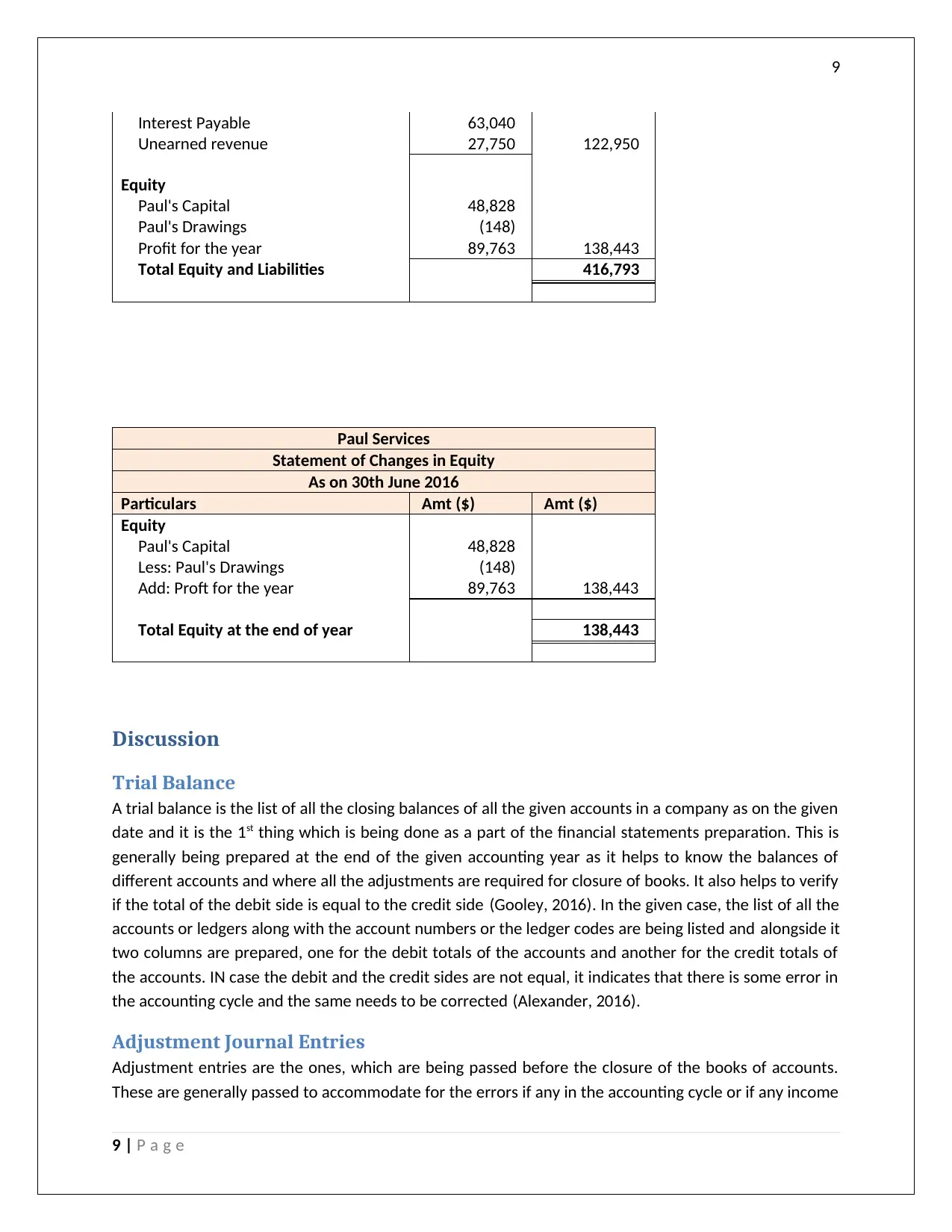
9
Interest Payable 63,040
Unearned revenue 27,750 122,950
Equity
Paul's Capital 48,828
Paul's Drawings (148)
Profit for the year 89,763 138,443
Total Equity and Liabilities 416,793
Paul Services
Statement of Changes in Equity
As on 30th June 2016
Particulars Amt ($) Amt ($)
Equity
Paul's Capital 48,828
Less: Paul's Drawings (148)
Add: Proft for the year 89,763 138,443
Total Equity at the end of year 138,443
Discussion
Trial Balance
A trial balance is the list of all the closing balances of all the given accounts in a company as on the given
date and it is the 1st thing which is being done as a part of the financial statements preparation. This is
generally being prepared at the end of the given accounting year as it helps to know the balances of
different accounts and where all the adjustments are required for closure of books. It also helps to verify
if the total of the debit side is equal to the credit side (Gooley, 2016). In the given case, the list of all the
accounts or ledgers along with the account numbers or the ledger codes are being listed and alongside it
two columns are prepared, one for the debit totals of the accounts and another for the credit totals of
the accounts. IN case the debit and the credit sides are not equal, it indicates that there is some error in
the accounting cycle and the same needs to be corrected (Alexander, 2016).
Adjustment Journal Entries
Adjustment entries are the ones, which are being passed before the closure of the books of accounts.
These are generally passed to accommodate for the errors if any in the accounting cycle or if any income
9 | P a g e
Interest Payable 63,040
Unearned revenue 27,750 122,950
Equity
Paul's Capital 48,828
Paul's Drawings (148)
Profit for the year 89,763 138,443
Total Equity and Liabilities 416,793
Paul Services
Statement of Changes in Equity
As on 30th June 2016
Particulars Amt ($) Amt ($)
Equity
Paul's Capital 48,828
Less: Paul's Drawings (148)
Add: Proft for the year 89,763 138,443
Total Equity at the end of year 138,443
Discussion
Trial Balance
A trial balance is the list of all the closing balances of all the given accounts in a company as on the given
date and it is the 1st thing which is being done as a part of the financial statements preparation. This is
generally being prepared at the end of the given accounting year as it helps to know the balances of
different accounts and where all the adjustments are required for closure of books. It also helps to verify
if the total of the debit side is equal to the credit side (Gooley, 2016). In the given case, the list of all the
accounts or ledgers along with the account numbers or the ledger codes are being listed and alongside it
two columns are prepared, one for the debit totals of the accounts and another for the credit totals of
the accounts. IN case the debit and the credit sides are not equal, it indicates that there is some error in
the accounting cycle and the same needs to be corrected (Alexander, 2016).
Adjustment Journal Entries
Adjustment entries are the ones, which are being passed before the closure of the books of accounts.
These are generally passed to accommodate for the errors if any in the accounting cycle or if any income
9 | P a g e
Paraphrase This Document
Need a fresh take? Get an instant paraphrase of this document with our AI Paraphraser
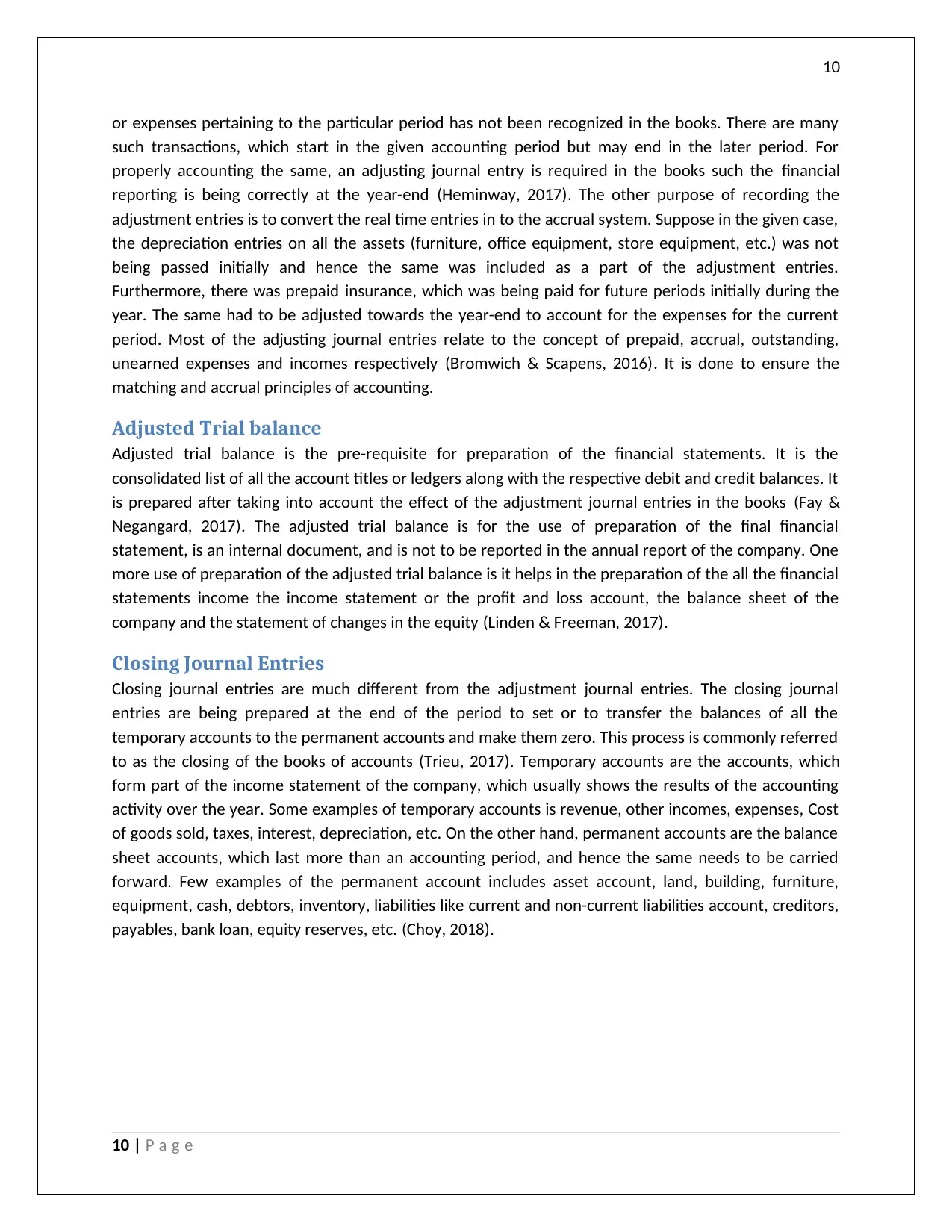
10
or expenses pertaining to the particular period has not been recognized in the books. There are many
such transactions, which start in the given accounting period but may end in the later period. For
properly accounting the same, an adjusting journal entry is required in the books such the financial
reporting is being correctly at the year-end (Heminway, 2017). The other purpose of recording the
adjustment entries is to convert the real time entries in to the accrual system. Suppose in the given case,
the depreciation entries on all the assets (furniture, office equipment, store equipment, etc.) was not
being passed initially and hence the same was included as a part of the adjustment entries.
Furthermore, there was prepaid insurance, which was being paid for future periods initially during the
year. The same had to be adjusted towards the year-end to account for the expenses for the current
period. Most of the adjusting journal entries relate to the concept of prepaid, accrual, outstanding,
unearned expenses and incomes respectively (Bromwich & Scapens, 2016). It is done to ensure the
matching and accrual principles of accounting.
Adjusted Trial balance
Adjusted trial balance is the pre-requisite for preparation of the financial statements. It is the
consolidated list of all the account titles or ledgers along with the respective debit and credit balances. It
is prepared after taking into account the effect of the adjustment journal entries in the books (Fay &
Negangard, 2017). The adjusted trial balance is for the use of preparation of the final financial
statement, is an internal document, and is not to be reported in the annual report of the company. One
more use of preparation of the adjusted trial balance is it helps in the preparation of the all the financial
statements income the income statement or the profit and loss account, the balance sheet of the
company and the statement of changes in the equity (Linden & Freeman, 2017).
Closing Journal Entries
Closing journal entries are much different from the adjustment journal entries. The closing journal
entries are being prepared at the end of the period to set or to transfer the balances of all the
temporary accounts to the permanent accounts and make them zero. This process is commonly referred
to as the closing of the books of accounts (Trieu, 2017). Temporary accounts are the accounts, which
form part of the income statement of the company, which usually shows the results of the accounting
activity over the year. Some examples of temporary accounts is revenue, other incomes, expenses, Cost
of goods sold, taxes, interest, depreciation, etc. On the other hand, permanent accounts are the balance
sheet accounts, which last more than an accounting period, and hence the same needs to be carried
forward. Few examples of the permanent account includes asset account, land, building, furniture,
equipment, cash, debtors, inventory, liabilities like current and non-current liabilities account, creditors,
payables, bank loan, equity reserves, etc. (Choy, 2018).
10 | P a g e
or expenses pertaining to the particular period has not been recognized in the books. There are many
such transactions, which start in the given accounting period but may end in the later period. For
properly accounting the same, an adjusting journal entry is required in the books such the financial
reporting is being correctly at the year-end (Heminway, 2017). The other purpose of recording the
adjustment entries is to convert the real time entries in to the accrual system. Suppose in the given case,
the depreciation entries on all the assets (furniture, office equipment, store equipment, etc.) was not
being passed initially and hence the same was included as a part of the adjustment entries.
Furthermore, there was prepaid insurance, which was being paid for future periods initially during the
year. The same had to be adjusted towards the year-end to account for the expenses for the current
period. Most of the adjusting journal entries relate to the concept of prepaid, accrual, outstanding,
unearned expenses and incomes respectively (Bromwich & Scapens, 2016). It is done to ensure the
matching and accrual principles of accounting.
Adjusted Trial balance
Adjusted trial balance is the pre-requisite for preparation of the financial statements. It is the
consolidated list of all the account titles or ledgers along with the respective debit and credit balances. It
is prepared after taking into account the effect of the adjustment journal entries in the books (Fay &
Negangard, 2017). The adjusted trial balance is for the use of preparation of the final financial
statement, is an internal document, and is not to be reported in the annual report of the company. One
more use of preparation of the adjusted trial balance is it helps in the preparation of the all the financial
statements income the income statement or the profit and loss account, the balance sheet of the
company and the statement of changes in the equity (Linden & Freeman, 2017).
Closing Journal Entries
Closing journal entries are much different from the adjustment journal entries. The closing journal
entries are being prepared at the end of the period to set or to transfer the balances of all the
temporary accounts to the permanent accounts and make them zero. This process is commonly referred
to as the closing of the books of accounts (Trieu, 2017). Temporary accounts are the accounts, which
form part of the income statement of the company, which usually shows the results of the accounting
activity over the year. Some examples of temporary accounts is revenue, other incomes, expenses, Cost
of goods sold, taxes, interest, depreciation, etc. On the other hand, permanent accounts are the balance
sheet accounts, which last more than an accounting period, and hence the same needs to be carried
forward. Few examples of the permanent account includes asset account, land, building, furniture,
equipment, cash, debtors, inventory, liabilities like current and non-current liabilities account, creditors,
payables, bank loan, equity reserves, etc. (Choy, 2018).
10 | P a g e
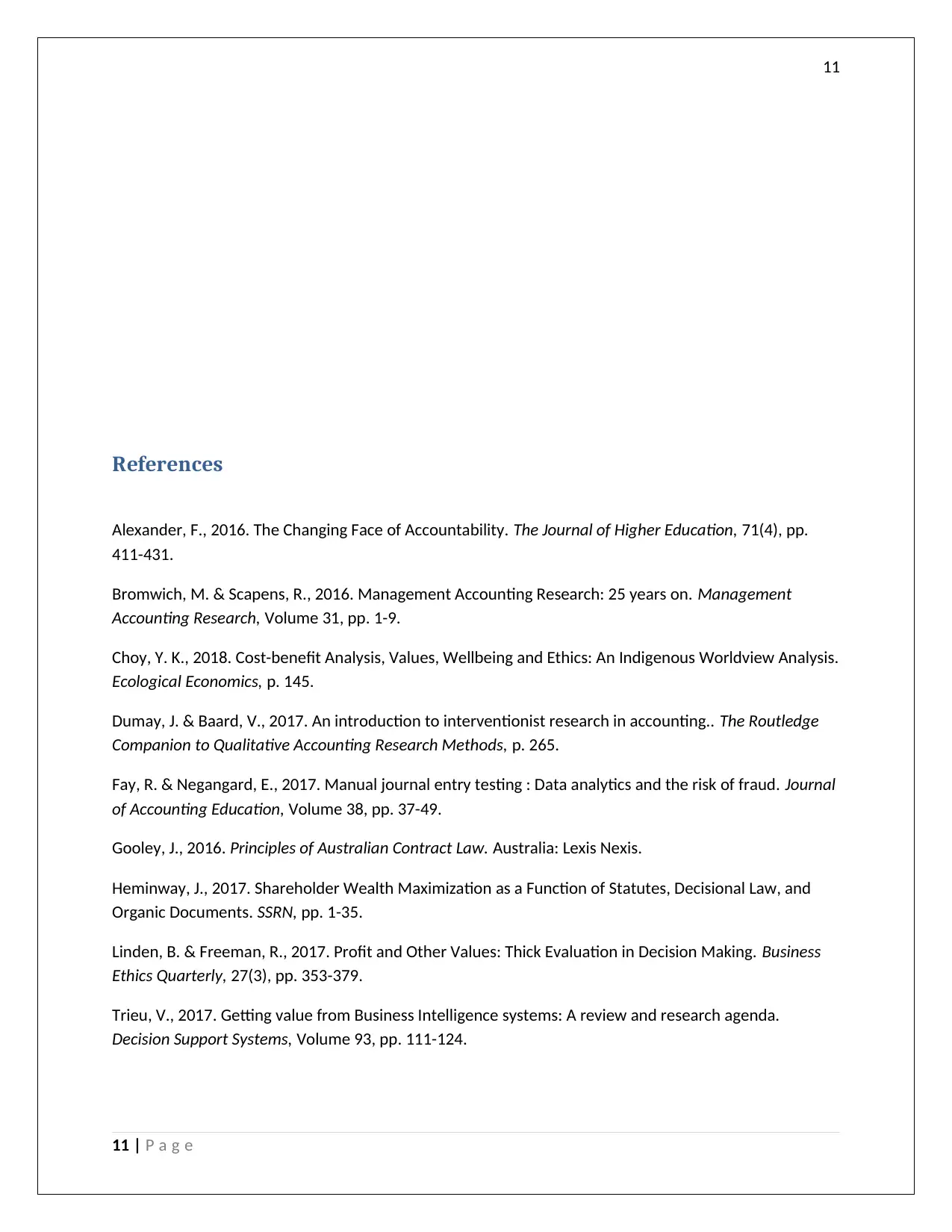
11
References
Alexander, F., 2016. The Changing Face of Accountability. The Journal of Higher Education, 71(4), pp.
411-431.
Bromwich, M. & Scapens, R., 2016. Management Accounting Research: 25 years on. Management
Accounting Research, Volume 31, pp. 1-9.
Choy, Y. K., 2018. Cost-benefit Analysis, Values, Wellbeing and Ethics: An Indigenous Worldview Analysis.
Ecological Economics, p. 145.
Dumay, J. & Baard, V., 2017. An introduction to interventionist research in accounting.. The Routledge
Companion to Qualitative Accounting Research Methods, p. 265.
Fay, R. & Negangard, E., 2017. Manual journal entry testing : Data analytics and the risk of fraud. Journal
of Accounting Education, Volume 38, pp. 37-49.
Gooley, J., 2016. Principles of Australian Contract Law. Australia: Lexis Nexis.
Heminway, J., 2017. Shareholder Wealth Maximization as a Function of Statutes, Decisional Law, and
Organic Documents. SSRN, pp. 1-35.
Linden, B. & Freeman, R., 2017. Profit and Other Values: Thick Evaluation in Decision Making. Business
Ethics Quarterly, 27(3), pp. 353-379.
Trieu, V., 2017. Getting value from Business Intelligence systems: A review and research agenda.
Decision Support Systems, Volume 93, pp. 111-124.
11 | P a g e
References
Alexander, F., 2016. The Changing Face of Accountability. The Journal of Higher Education, 71(4), pp.
411-431.
Bromwich, M. & Scapens, R., 2016. Management Accounting Research: 25 years on. Management
Accounting Research, Volume 31, pp. 1-9.
Choy, Y. K., 2018. Cost-benefit Analysis, Values, Wellbeing and Ethics: An Indigenous Worldview Analysis.
Ecological Economics, p. 145.
Dumay, J. & Baard, V., 2017. An introduction to interventionist research in accounting.. The Routledge
Companion to Qualitative Accounting Research Methods, p. 265.
Fay, R. & Negangard, E., 2017. Manual journal entry testing : Data analytics and the risk of fraud. Journal
of Accounting Education, Volume 38, pp. 37-49.
Gooley, J., 2016. Principles of Australian Contract Law. Australia: Lexis Nexis.
Heminway, J., 2017. Shareholder Wealth Maximization as a Function of Statutes, Decisional Law, and
Organic Documents. SSRN, pp. 1-35.
Linden, B. & Freeman, R., 2017. Profit and Other Values: Thick Evaluation in Decision Making. Business
Ethics Quarterly, 27(3), pp. 353-379.
Trieu, V., 2017. Getting value from Business Intelligence systems: A review and research agenda.
Decision Support Systems, Volume 93, pp. 111-124.
11 | P a g e
⊘ This is a preview!⊘
Do you want full access?
Subscribe today to unlock all pages.

Trusted by 1+ million students worldwide
1 out of 13
Related Documents
Your All-in-One AI-Powered Toolkit for Academic Success.
+13062052269
info@desklib.com
Available 24*7 on WhatsApp / Email
![[object Object]](/_next/static/media/star-bottom.7253800d.svg)
Unlock your academic potential
Copyright © 2020–2025 A2Z Services. All Rights Reserved. Developed and managed by ZUCOL.





